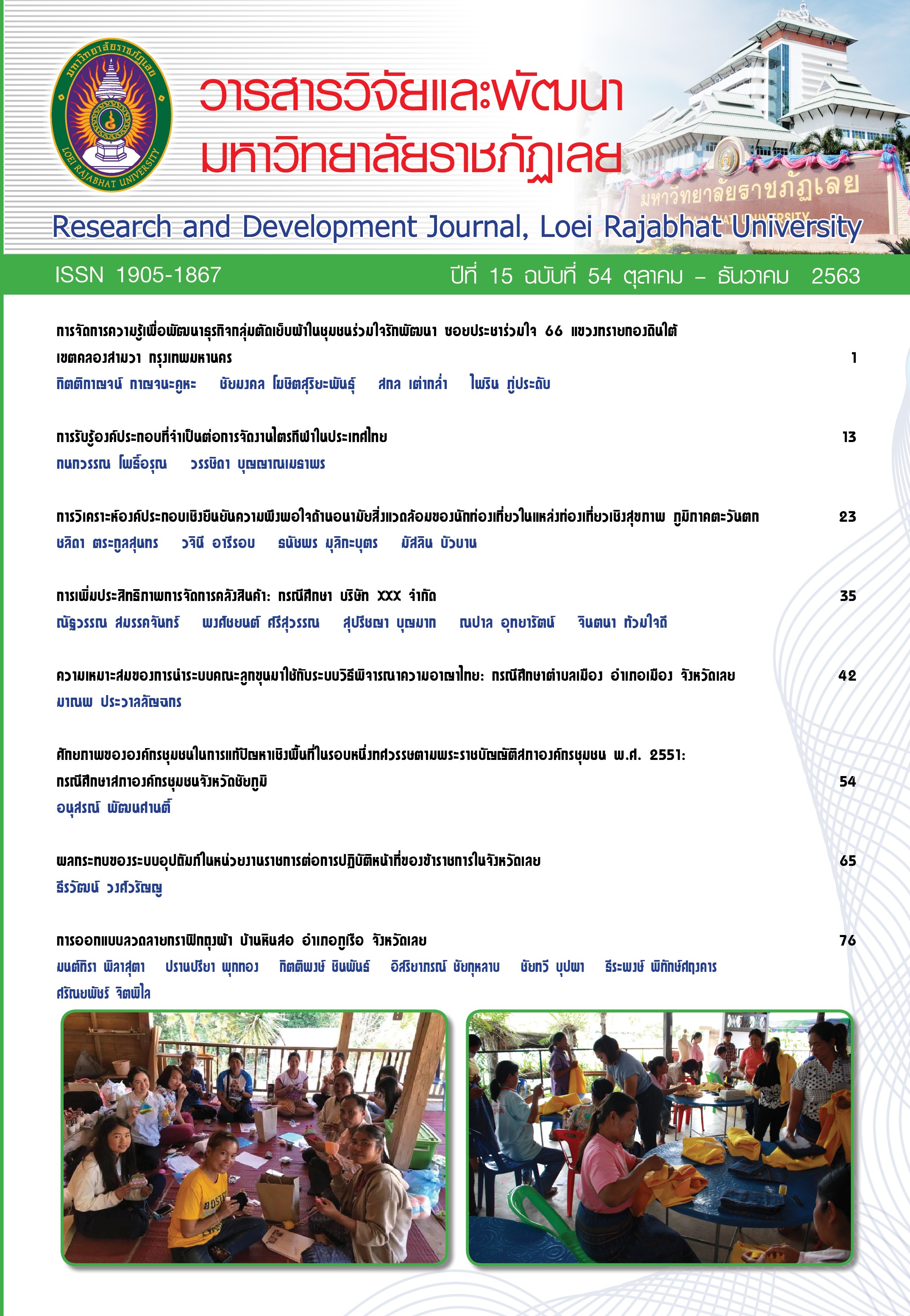The Ability of Community Organization to Solving Area Problem, According to the Federation of Community Organizations Act BE 2551: A Case Study of Chaiyaphum Community Organization Council
Keywords:
Chaiyaphum community organization, the federation of community organizations act B.E. 2551, policy advocacyAbstract
There are 3 objectives of the research entitled “The Ability of Community Organization in Solving Area Problem according to the Federation of Community Organizations Act B.E. 2551: A Case Study of Chaiyaphum Community Organization Council”: 1) to study and analyze the development and the roles of Chaiyaphum Community Organization Council in the past 10 years under the Federation of Community Organizations Act B.E. 2551, 2) to study the key issues in advocating for being the community and provincial policies as well as the mechanism of management of the community organization procession in Chaiyaphum province from 2008-2018, and 3) to study the results of the policy advocacy and the implementation of plan and the results of the policy change of Chaiyaphum Community Organization Council from 2008-2018 by using qualitative research methodology.
The results of the research were as follows.
1. Chaiyaphum Community Organization was before Federation of Community Organizations Act B.E. 2551, including community welfare, environmental resource management and solutions for area and land problems. This led to the emergence of Federation of Community Organizations Act B.E. 2551 and sign to be Chaiyaphum Community Organization Council under Chaiyaphum community organization procession.
2. In terms of the key issues in advocating for community and provincial policies, at the initial phase of the Federation of Community Organizations Act B.E. 2551, there was a variety of issues. Moreover, the government agencies and the general public did not understand the roles of Chaiyaphum Community Organization Council. As for the mechanism of administration of the community organization procession, Chaiyaphum Province did not have any guidelines and the exact location for coordination. After 2014 to the present, Community Organizations Development Institute has supervised for the development directions, so the activities can be continuously organized.
3. For the policy and the results of the changes from the policy advocacy of Chaiyaphum Community Organization Council on the provincial agencies, there were coordination with and dependence on external agencies. As a result, the policy was in the framework of activity determination rather than pushing problems directly from the area.
The recommendations from this research are as follows. The activities should not be set for Chaiyaphum Community Organization Council to proceed in its area. The external agencies should determine the problems that are from the needs of the areas in order to push into the policy at the provincial level.
References
ณัฐวุฒิ อ่าวสกุล. (2558). กระบวนการประชาธิปไตยในสภาองค์กรชุมชนและเครือข่ายภาคประชาชนในพื้นที่ภาคกลาง (วิทยานิพนธ์ปริญญาปรัชญาดุษฎีบัณฑิต). มหาวิทยาลัยรามคำแหง, กรุงเทพฯ.
ปัญญวัฒน์ กระทุ่มเขต. (2556). ปัจจัยที่มีผลต่อการนำนโยบายชุมชนท้องถิ่นจัดการตนเองมาปฏิบัติในจังหวัดจันทบุรี: กรณีศึกษาการขับเคลื่อน ของสภาองค์กรชุมชนตำบล (ภาคนิพนธ์ปริญญารัฐประศาสนศาสตรมหาบัณฑิต). มหาวิทยาลัยราชภัฏรำไพพรรณี, จันทบุรี.
เรืองวิทย์ เกษสุวรรณ. (2552). นโยบายสาธารณะเชิงวิพากษ์. วารสารพัฒนบริหารศาสตร์, 49(1), 41–66.
เสกสรรค์ ประเสริฐกุล. (2548). การเมืองภาคประชาชนในระบอบประชาธิปไตยไทย. กรุงเทพฯ: สำนักพิมพ์อมรินทร์.
หิรัญญ์ หิรัญพิพัฒน์. (2551). บทบาทสภาองค์กรชุมชนกับการสร้างความเข้มแข็งให้กับชุมชนท้องถิ่น: ศึกษากรณีสภาองค์กรชุมชน ตำบลหนองสาหร่าย จังหวัดกาญจนบุรี (วิทยานิพนธ์ปริญญาศิลปศาสตรมหาบัณฑิต). มหาวิทยาลัยรามคำแหง, กรุงเทพฯ.
Kraft, M. E., & Furlong, S.R. (2007). Public policy: Politics, analysis, and alternatives (2nd ed.). Washington, D.C.: CQ Press.
Downloads
Published
How to Cite
Issue
Section
License
ข้อความที่ปรากฎในวารสารฉบับนี้เป็นความคิดเห็นของผู้เขียนแต่ละท่าน สถาบันวิจัยและพัฒนา มหาวิทยาลัยราชภัฏเลย และกองบรรณาธิการ ไม่จำเป็นต้องเห็นด้วยและไม่มีส่วนรับผิดชอบใดๆ
สถาบันวิจัยและพัฒนา มหาวิทยาลัยราชภัฏเลย ขอให้ผู้อ่านอ้างอิงในกรณีที่ท่านคัดลอกเนื้อหาบทความในวารสารฉบับนี้






